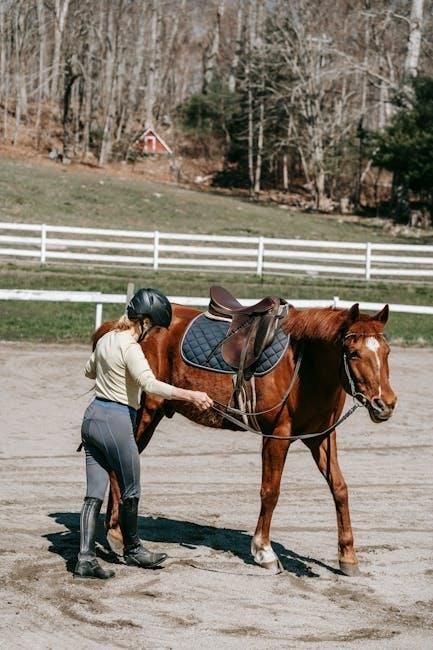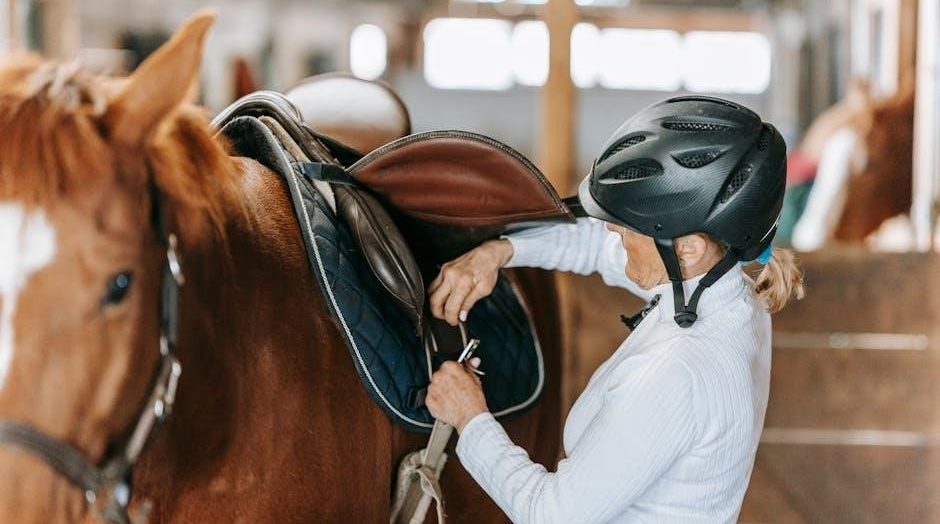A properly fitted horse riding helmet is essential for safety, comfort, and confidence․ This guide helps riders determine the correct size, ensuring optimal protection and performance․ Learn how to measure, choose, and adjust your helmet for a secure and comfortable fit every time you ride․
Importance of Proper Helmet Fit
A proper helmet fit is crucial for both safety and performance while horse riding․ A helmet that fits correctly ensures optimal protection in the event of a fall or impact, distributing force evenly and reducing the risk of head injury․ If the helmet is too loose, it may shift during riding, failing to protect vulnerable areas like the temples or the back of the head․ Conversely, a helmet that is too tight can cause discomfort and even restrict blood flow, leading to headaches or fatigue․ A well-fitting helmet also enhances riding confidence, as it stays securely in place regardless of movement or speed․ Proper fit ensures the helmet aligns with safety certifications, as it is designed to function correctly only when worn appropriately․ Additionally, a comfortable helmet reduces distractions, allowing riders to focus on their technique and connection with the horse․ Prioritizing a proper fit is essential for maximizing safety, comfort, and overall riding experience․

How to Measure Your Head for a Horse Riding Helmet
To measure your head, use a flexible tape measure․ Place it around the widest part of your head, just above your eyebrows and ears, keeping it level and snug․ Have someone assist for accuracy․ Natural hair thickness and head shape can affect the fit, so consider these factors when measuring․
3․1 Step-by-Step Guide to Measuring Your Head
To ensure an accurate fit, follow these steps to measure your head for a horse riding helmet:
- Use a flexible tape measure or a string that can wrap around your head․
- Position the tape measure just above your eyebrows and ears, ensuring it is level and not tilted․
- Gently pull the tape measure snug but not too tight—this should mimic the fit of a helmet․
- Have someone assist you to ensure the tape measure stays in place and the measurement is accurate․
- Record the measurement in inches or centimeters and compare it to the helmet size chart․
Your head shape and hair thickness can affect the fit, so consider these factors when selecting your size․ Take multiple measurements if needed to ensure consistency and accuracy․
3․2 Understanding Different Head Shapes
Head shapes vary among individuals, and understanding yours is crucial for achieving the best helmet fit․ Common head shapes include oval, round, and long (egg-shaped)․ Oval heads are the most common, with balanced proportions․ Round heads have a similar width and length, while long heads are narrower and longer from front to back․
- Oval heads: These are the easiest to fit, as most helmets are designed for this shape․ The helmet will sit comfortably without pressure points․
- Round heads: These may require a helmet with a slightly wider fit to prevent pressure on the forehead and ensure even distribution around the skull․
- Long heads: These benefit from helmets with a more elongated shape or adjustable features to accommodate the length without causing discomfort․
Some helmets cater to specific head shapes, so trying them on is essential․ Brands often design helmets with adjustable padding or retention systems to accommodate variations in head shape․ Understanding your head shape ensures a more precise fit, enhancing both safety and comfort while riding․ Proper fit is vital for protection, so take the time to identify your head shape and choose a helmet that aligns with it․

Choosing the Right Helmet Size
Use a size chart to determine your helmet size, ensuring a snug, even fit․ Try helmets on if possible, as brands vary slightly․ Adjust the retention system for security and comfort, ensuring no pressure points for optimal protection and confidence while riding․
4․1 Standard Helmet Size Charts
Standard helmet size charts provide a consistent reference for determining your ideal fit․ These charts typically correlate head circumference measurements with specific helmet sizes, ranging from small to extra-large․ To use the chart effectively, measure your head circumference just above your eyebrows and around the widest part of your skull․ Compare this measurement to the chart to identify your corresponding size․ Most brands adhere to these standards, ensuring consistency across different manufacturers․ However, slight variations may exist due to differences in helmet shapes and padding․ Always check the specific chart provided by the brand when selecting a helmet․ This approach ensures a more accurate fit, enhancing both safety and comfort during rides․
4․2 How Brand Variations Affect Sizing
While standard helmet size charts provide a general guide, variations between brands can influence the fit․ Different manufacturers may have slightly different interpretations of sizes, leading to discrepancies in how helmets sit on the head․ For example, one brand’s medium might feel tighter or looser compared to another’s medium, even if the head circumference measurements align․ This is often due to differences in helmet design, padding thickness, and head shape accommodations․
Some brands cater to specific head shapes, such as round or oval, which can affect how the helmet fits․ Additionally, certain brands may use more or less padding, altering the overall feel of the helmet․ Riders should not assume their size will be consistent across all brands and should try helmets from multiple manufacturers to find the best fit․
Consulting the sizing charts provided by each brand and reading reviews can help identify potential variations․ This ensures that the chosen helmet not only meets safety standards but also provides a comfortable and secure fit for optimal riding performance․

Safety Certifications and Standards
Safety certifications and standards are critical when selecting a horse riding helmet, ensuring it meets rigorous testing for impact protection, durability, and reliability․ Helmets must pass stringent safety standards set by organizations like the ASTM International (formerly American Society for Testing and Materials) and the SEI (Safety Equipment Institute)․ These standards evaluate factors such as impact absorption, penetration resistance, and retention system strength․
In the U․S․, the ASTM F1163 standard specifically applies to equestrian helmets, requiring helmets to withstand various impact tests․ Similarly, the VG1 standard in Europe and the AS/NZS 3838 standard in Australia and New Zealand ensure compliance with regional safety requirements․ Look for helmets labeled with these certifications to confirm they meet safety benchmarks․
Some helmets may carry multiple certifications, indicating they satisfy several international standards․ Riders should always verify the certification labels and avoid helmets without recognized safety approvals․ Adhering to these standards ensures the helmet provides reliable protection in the event of a fall or impact, making them indispensable for rider safety;

How to Adjust Your Horse Riding Helmet
Properly adjusting your helmet ensures a secure, comfortable fit․ Use the retention system to tighten or loosen the fit around your head, and adjust the internal padding for a snug, even feel․ Proper adjustment is key to safety and comfort while riding․
6․1 Fitting the Helmet Correctly
Fitting a horse riding helmet correctly is crucial for both safety and comfort․ Start by placing the helmet on your head without tilting it back or forward․ The helmet should sit level, with the front edge resting just above your eyebrows․ Ensure the helmet does not feel too tight or too loose, as this can cause discomfort or compromise protection․
- Check the fit by gently rocking the helmet from side to side and front to back․ It should not move excessively but should also not feel constricting․
- Adjust the retention system (chin strap) to secure the helmet firmly under your chin․ The straps should form a “V” shape around your ears and lie flat against your head․
- If the helmet has adjustable padding, use it to fine-tune the fit․ The padding should distribute pressure evenly, avoiding pressure points․
- Try the helmet on with your hair tied back to ensure a consistent fit, as loose hair can affect how the helmet sits on your head․
A properly fitted helmet will stay in place during movement, providing reliable protection․ If you feel any pressure points or discomfort, further adjustments or a different size may be necessary․ Always prioritize a snug, secure fit to ensure optimal safety and performance while riding․
6․2 Adjusting the Retention System
Adjusting the retention system of your horse riding helmet is vital to ensure a secure and comfortable fit․ The retention system, typically consisting of a chin strap and adjustable straps, prevents the helmet from shifting during riding․ Begin by fastening the chin strap snugly under your chin, ensuring it is neither too tight nor too loose․ The straps should form a “V” shape around your ears, lying flat against your head without causing discomfort or pressure․
- Adjust the length of the chin strap so that only one or two fingers fit between the strap and your chin․ This ensures a firm hold without restricting movement․
- Tighten or loosen the side straps to position the helmet evenly on your head․ The front of the helmet should sit just above your eyebrows, and the back should not dig into your neck․
- If your helmet has a dial-fit system, use it to fine-tune the fit by turning the dial to adjust the circumference of the headband․ This feature allows for precise customization to accommodate different head shapes and sizes․
- Test the retention system by gently tugging on the helmet․ It should stay firmly in place without moving excessively, indicating a proper fit․
A well-adjusted retention system ensures the helmet stays secure during various riding movements, providing consistent protection and comfort․ Regularly check and adjust the system to maintain optimal fit and safety․

Trying the Helmet On
When trying on a horse riding helmet, ensure it feels comfortable and secure from the moment you put it on․ A proper fit should be snug but not overly tight, with the helmet sitting level on your head․ The front edge should rest just above your eyebrows, while the back should not press into your neck or scalp․
- Check that the helmet does not move when you shake your head gently from side to side or nod up and down․ Excessive movement indicates a poor fit․
- The padding inside the helmet should evenly distribute pressure, avoiding hotspots or discomfort․ If the helmet feels too tight or causes discomfort, consider a larger size or a different model․
- Pay attention to the gap between your head and the helmet․ There should be no significant space, as this could compromise safety in the event of an impact․
- If the helmet has adjustable padding, use it to fine-tune the fit for your head shape․ Ensure the retention system is properly secured to maintain stability․
Trying the helmet on with your hair styled as you typically wear it while riding is also important, as this can affect the fit․ A well-fitting helmet ensures comfort, confidence, and most importantly, reliable protection while riding․

Maintenance and Care Tips
Proper maintenance and care of your horse riding helmet are crucial to ensure its longevity and safety effectiveness․ Regular cleaning and inspections help maintain its protective qualities and overall condition․
- Wipe the helmet’s exterior and interior with a soft cloth and mild soap solution to remove dirt, sweat, and oils․ Avoid harsh chemicals that could damage the materials․
- Store the helmet in a cool, dry place away from direct sunlight to prevent degradation of the shell and padding․
- Inspect the helmet regularly for signs of wear, such as cracks, dents, or frayed straps․ If damage is found, replace the helmet immediately․
- Avoid leaving the helmet in a hot vehicle or exposed to extreme temperatures, as this can compromise its structural integrity․
- Replace the padding and liners periodically, especially if they show signs of wear or become soiled․
Following the manufacturer’s care instructions ensures your helmet remains in optimal condition․ Regular maintenance not only extends the helmet’s lifespan but also guarantees it continues to provide reliable protection during rides․

Common Fit Issues and Solutions
Common fit issues include helmets that are too tight, too loose, or uneven․ These problems can cause discomfort and reduce safety․ Solutions involve adjusting the fit system, using additional padding, or consulting sizing charts to ensure a secure and balanced fit․
Addressing these issues promptly ensures optimal protection and riding comfort, preventing potential safety risks and discomfort during rides․
9․1 Troubleshooting Poor Fit
If your helmet feels uncomfortable or doesn’t sit correctly, it may be due to improper sizing or adjustment․ A common issue is a helmet that slides backward or forward, indicating a poor fit․ To address this, check the retention system and ensure it is snug but not overly tight․
If the helmet feels too tight, it may be the wrong size, or the padding is compressing unevenly․ Consider trying a larger size or adding extra padding for a more customized fit․ Conversely, if the helmet is too loose, try a smaller size or tighten the retention system for better stability․
Another issue is uneven pressure points, which can cause discomfort during long rides․ This often occurs when the helmet doesn’t match the rider’s head shape․ Experimenting with different brands or models designed for your specific head shape can resolve this problem․ Additionally, ensure the helmet sits level on your head, with the front edge no more than one inch above your eyebrows․
By addressing these common fit issues, riders can achieve a more secure, comfortable, and protective helmet fit, enhancing both safety and performance while riding․ Proper troubleshooting ensures the helmet functions as intended, providing peace of mind for every ride․
Selecting the right horse riding helmet size is crucial for safety, comfort, and performance․ A proper fit ensures optimal protection, reduces the risk of injury, and enhances your riding experience․ By following the steps outlined in this guide, you can accurately measure your head, choose the correct size, and adjust your helmet for a secure fit․ Remember, proper fit isn’t just about size—it also depends on your head shape and how the helmet sits on your head․ Always try helmets on if possible, as brands may vary slightly in sizing and design․ Regular maintenance and care will extend the life of your helmet and ensure it continues to provide reliable protection․ Whether you’re a seasoned rider or just starting out, taking the time to find the perfect fit will allow you to ride with confidence and peace of mind․ A well-fitted helmet is an investment in your safety and enjoyment of horse riding․ Happy trails!
